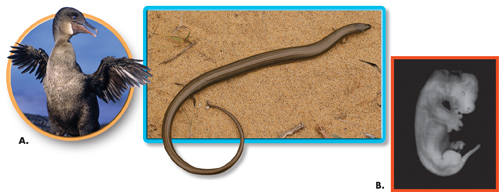
FIGURE 16–15 Vestigial Organs and Embryology A. The wings of the flightless cormorant and the legs of the Italian three-toed skink are vestigial structures. B. Because the early stages of development among vertebrates are so similar, it would take an expert to identify this as an opposum embryo. Infer Looking at the legs of the skink, do you think its ancestors had functioning legs? Explain your answer.
▸ Analogous Structures Note that the clue to common descent is common structure, not common function. A bird's wing and a horse's front limb have different functions but similar structures. Body parts that share common function, but not structure, are called analogous structures. The wing of a bee and the wing of a bird are analogous structures.
 In Your Notebook Do you think the shell of a clam and the shell of a lobster are homologous or analogous structures? Explain.
In Your Notebook Do you think the shell of a clam and the shell of a lobster are homologous or analogous structures? Explain.
▸ Vestigial Structures Not all homologous structures have important functions. Vestigial structures are inherited from ancestors but have lost much or all of their original function due to different selection pressures acting on the descendant. For example, the hipbones of the bottlenose dolphin, shown on page 467, are vestigial structures. In their ancestors, hipbones played a role in terrestrial locomotion. However, as the dolphin lineage adapted to life at sea, this function was lost. Why do dolphins and the organisms in Figure 16–15 retain structures with little or no function? One possibility is that the presence of the structure does not affect an organism's fitness, and, therefore, natural selection does not act to eliminate it.
Embryology Researchers noticed a long time ago that the early developmental stages of many animals with backbones (called vertebrates) look very similar. Recent observations make clear that the same groups of embryonic cells develop in the same order and in similar patterns to produce many homologous tissues and organs in vertebrates. For example, despite the very different adult shapes and functions of the limb bones in Figure 16–14, all those bones develop from the same clumps of embryonic cells. Evolutionary theory offers the most logical explanation for these similarities in patterns of development.  Similar patterns of embryological development provide further evidence that organisms have descended from a common ancestor.
Similar patterns of embryological development provide further evidence that organisms have descended from a common ancestor.
Darwin realized that similar patterns of development offer important clues to the ancestory of living organisms. He could not have anticipated, however, the incredible amount of evidence for his theory that would come from studying the genes that control development—evidence from the fields of genetics and molecular biology.
Table of Contents
- Formulas and Equations
- Applying Formulas and Equations
- Mean, Median, and Mode
- Estimation
- Using Measurements in Calculations
- Effects of Measurement Errors
- Accuracy
- Precision
- Comparing Accuracy and Precision
- Significant Figures
- Calculating With Significant Figures
- Scientific Notation
- Calculating With Scientific Notation
- Dimensional Analysis
- Applying Dimensional Analysis




